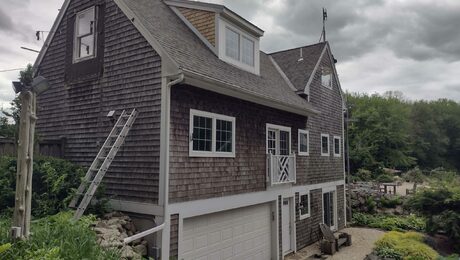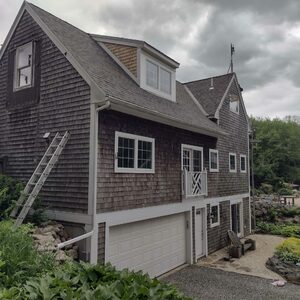I am about to embark on a repaint of my master bathrron because the paint has failed. Thing is I’m not sure if it was my prep the first time of the paint itself. So I am looking for advice/ guidance.
When I bought the house in 1998, ceiling was flat paint and mildewed. Killed mildew with bleach/water. Then painted the ceiling and all walls with KILZ white tinted shellac. NOT the water based stuff. The stuff that makes you fall off the ladder when used in the confines of a bathroom.
Topcoated the KILZ with Semigloss White Bathroom paint with Mildewcide (Latex) KILZ instructions say this is OK. The good news is the mildew has not come back. But now, I have these brown drips on the ceiling and walls. I don’t think its dirt condensing from steam. Because the drips run down the wall and are rock hard, won’t wash off. Someone suggested once excess iron from the well water, but there was no exidence of this problem when we first moved in and in the subsequent months that the BR was in use prior to the repaint. So I’m thinking it’s a paint problem and I don’t know how to fix it. Before I can figure that out, I need help figuring out what these brown drips are.
They look like beads of water running down the wall, then the brown drips dry and get rock hard. They also appear in different places on the ceiling where the paint is blistered.
Any ideas out there? There is a fart fan in the room on a sprung wound switch that is run when the shower is in use and for about 15 minutes afterwards. I put the fan in and it does draw out moist air. Would a larger fan help? THe one there is 150cfm i think, and the BR is small about 8×10 including the shower stall.



















Replies
The first thing I would do is to get in the attic and see what is going on there.
Where does the fan exhaust to?
You painted the bath in 98? Did you start seeing the brown streaks right away?
Do a google on "surfactant leaching"
Bill-
Vents out the roof- so it's not dumping hot moist air in the attic.
Barry-
Thanks for that input- looks like the surfactant leaking is where its at.
Now since it's latex paint that has the problem would you guys reccommend using an oil based paint in there? I would rather use latex . . . . .
I would still use a good acrylic latex enamel, just make sure you give it time to cure before dumping all of the moisture from the shower in there. Get some cross ventilation going to help it cure. Though the oil paint won't tend to leach, it still takes a while to dryGive the walls a scrubbing with TSP before you paint. You say the fan is vented out the roof and 150 cfm should be big enough for a 80 sf bath, but how old is the fan?
Barry E-Remodeler
Barry,
Is it the Shellac from the primer, reforming on the inside?
-zen
One of my first thoughts on reading this thread was that the Kilz wasn't completely cured before the latex was applied. depends on how much air movement there is in this bathroom I guess. But I'm guessing it's from the topcoat not being fully cured and components of the paint are leaching. Or maybe a combo of the two. Hard to say with out seeing it. I haven't used the mildew resistant latex paint much, have you? Could just be tobacco smoke and soap scum mixing with the moisture from the shower. <g> but that would wash off easier.
Barry E-Remodeler
Barry,
I think I have used a number of paints with Mildewicide in them, but no product that promoted that as the purpose, and I have never added the little packs.
Im in Maine, and although the air can be humid I honestly havent seen to many problem baths. (That being a fairly small cause compared to the shower) Only in grubby tubs not on the walls.
Even when they are like a closet, except for failing or crackled paint, overall no messes. Im sure a ton of them dont use their fans either, and heck my place doesnt have a fan, has flat wall paint that has probably been there 25 years and its not mildewed. -can you tell I do this for work?
-zen
Oh back to the other, it just went through my mind earlier that because shellac is water soluble, I wonder if the steam could pass the latex barrier, then the water molecules on the room side, draw the shellac through the latex.
Latex paint is made to allow the much smaller steam molecule through. Because of hydrogen bonds water as a liquid cant penetrate the latex. If the water beads collected on the room side maybe the force could suck the shellac through, or the shellac could pass because it is a much smaller molecule. It would make sense that the constant steam could rehydrate the shellac. I am a shellac lover, but everything has its limitations.
Just a crazy thought.
OK so here is the test:
Frontier, go to the bath and see if alcohol will dissolve your little brown solid drips, if it does, my overactive mind guess is that its shellac.
-zen
Edited 5/10/2005 7:11 pm ET by zendo
Edited 5/10/2005 7:14 pm ET by zendo
It's never happened that way in my experience, but anything is possible. If that were the case it might depend on what's underneath the shellac or how the surface was prepared.i've never used the bath paint for the same reason, I've never really had p a problem with acrylics or even vinyl latex that I can remember.
Barry E-Remodeler
Shellac becomes water soluble if mixed with an alkali.Do you know the PH of your water?Water vapor will pass thru latex paint, but shellac is a dang good water vapor barrier. Alkali water droplets could be condensing on the shellac barrier coat and making it water soluble. It then leeches thru your paint and voila.........rock hard "brownish" droplets.How's your attic insulation?Might be all you need is a better fan, shorter showers and more insulation.If the above is the case, a couple coats of oil-based paint would serve you much better because OB is a better vapor barrier than latex. Hopefully the water vapor wouldn't get thru and dissolve the shellac.Like Zendo.......I say try some denatured alcohol on those droplets. Or see if they're softer immediately after showering.Edit: Does this bathroom have a source of make-up air for the fan.........like is the door cut off for an air gap? If not, you're not moving near as much air as your fan is rated to move. Knowledge is power, but only if applied in a timely fashion.
Edited 5/10/2005 11:27 pm ET by GOLDHILLER
Wow- so much info to process here. To answer a few questions:
1) No smoking in the house. Ever. Previous (original) owners were non-smokers and I never smoked in the house before I reformed (3 months smoke free now, but that's another story)
2) The droplets DO NOT wash off, I will try the denatured alcohol trick.
3) Water is acidic. I'm in MD, copper pipes last about 20-30 years here then develop pinhole leaks from the water.
4) BR is upstairs on an outside corner but ceiling is well insulated. I can add more though and see if it helps.
5) Door has sufficient space underneath for makeup air. Fan is new in 98. I added it before repainting. I want to replace with an attic mounted fan and may do that before reworking the paint.
Is the fan properly vented to the outside???
You betcha.
You might want to see the previous post.Well....you should.We screwed up. <G>Knowledge is power, but only if applied in a timely fashion.
Thinking this over,Where are you and Zendo getting the shellac from? Kilz original is oil based, Bin is shellac based. I don't think that Kilz has an alcohol based sealer.
Barry E-Remodeler
Oh my. You are so correct that it hurts. <G> My mind fixated on the word "shellac"."When I bought the house in 1998, ceiling was flat paint and mildewed. Killed mildew with bleach/water. Then painted the ceiling and all walls with KILZ white tinted shellac."Argh. Shouldn't have done that cause I know that Kilz Original is an alternative to white-pigmented shellac sealers like BIN. Different composition.Anyway, here's the contents of Kilz Original and I suspect it plays a role here as the report from Frontier says this didn't happen before he bleached, sealed and painted."Ingredients from MSDS/Label
Chemical CAS No / Unique ID Percent
Talc (non-fibrous) 014807-96-6 15-30
Titanium dioxide 013463-67-7 5-15
Solvent naphtha, petroleum, medium aliphatic 064742-88-7 14.94
Solvent naphtha, petroleum, light aliphatic 064742-89-8 21.29
Linseed oil, polymer with pentaerythritol, phthalic anhydride, soybean oil, styrene and vinyltoluene 071243-64-6 15-25 "I would now conjecture that what we are told is the acidic nature of his water vapor passing thru the latex topcoats and condensing on the Kilz is re-liquifying the linseed and/or the soybean oil contents of the primer (alkyds, in this instance) and those are leaching to the surface where they again harden/oxidize once the water evaporates. I seriously doubt these are just surfactants leaching out of the latex paint as a result of acidic condensation, but maybe. I'm not a pro chemist by any stretch. But IME surfactant leaching is easily removed with detergent and water. Doesn't sound like what he's battling at all.BIN over the current problem *might* work, but I've gotta say that if enough water is condensing on the ceiling and walls to form droplets and runs of stuff, then ventilation seems inadequate. IMO, a well-ventilated and adeqautely insulated bathroom shouldn't condense at all........unless of course......you have teenagers taking LONG HOT showers. <G> I have an "alternative" paint barrier suggestion that I'm pretty sure would work well to resolve the issue, but won't post it right now cause folks would roll their eyes and exclaim .....this guy is nuts. LOL Maybe the placement of the vent fan isn't directly over the shower area and should be.Edit: Bottom line...........you caught our oversight. <G>Knowledge is power, but only if applied in a timely fashion.
Edited 5/11/2005 11:02 pm ET by GOLDHILLER
I see so many people say Kilz and shellac white pigmented on here I guess I have just figured they made a shellac product as well. I wondered that myself when he said it knocked him off the ladder... alcohol is nothing like the oil based when it comes to VOCs
BUT, BAM! The collective mind came up with some answers, again. This is what its all about.
So Frontier did you use Kilz Original, or Bin Shellac?
The cool thing is now we have leads for problems with both.
-zen
Edited 5/12/2005 5:41 am ET by zendo
I have used both in the past, but this was KILZ original. As I said before, this is upstairs and two walls are outside walls since it's an exterior corner. The majority of the problem is on the ceiling, but there are some drips on the walls running down. Insulation is cheap- so I will beef up insulation on ceiling. Then reread all of these posts re: the kilz chemistry to try and sort out what's going on.
And just so you guys are aware- the fan SEEMS to be doing its job. Mirror doesn't even fog when fan is running. So it's not like big pools of water condensing everywhere.
I figure your fan is probably big enough, and the Kilz is oil based, so its solvents should be mineral spirits or naphtha. Naphtha just has a shorter flash time like alcohol to water.
-zen
Had this happen once in a kit, and bath in an apt. Primed it with Bin latez primer, painted it flat white latex, two humid days later, little blister bubbles, and brown drips all over the ceil. Turns out it was residue from a family of heavy smokers who all sat around the kit table puffing away.
However, I cleaned it up, applied Zinser shellac primer, then re-painted it, 10 months now, so far so good. Don't know why it came through your primer though. Shellac usually stops tobacco, and any other water soluable stain. Are your stains "cleanable" with a wet rag? If not my only suggestion would be to try latex primer on a small part.
An old painter once told me water based primer for oil based stains, and oil based primer for water based stains. If primer base matches stain base it re-activates the stain.
I get brown drips in our bath too, no one here smokes, no one ever did. I primed with Kilz Premium and painted with latex (after washing walls with bleach and sanding). But the brown droplets and runs in our bathroom are easily rubbed away with a damp cloth, so probably not the same. I figured it was dirt and mildew. The latex paint bubbles up every time we take a shower, but usually settles back flat between times. I hate painting bathrooms! Next time I'm using Permawhite; I don't care how nasty it is to use!
Yeah, I would suspect condensation in the wall/ceiling, based on your description. Check that there aren't any leaks in the fan ductwork, and that there is appropriate insulation/ventillation above (if this is the top floor).
I had a similar problem with the ceiling in a bathroom with brownish-red drops or circles on the ceiling about 2 weeks after finishing it. Never did find our or figure out what the problem was.
Wade